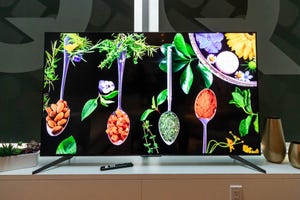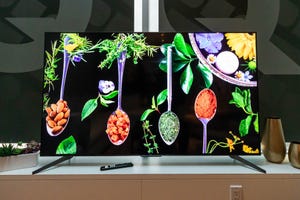
TCL Google TVs Promise Improved Picture, Smooth Gaming Starting at $500 - CNET
My pick for best TV overall right now is the TCL 6-Series Roku TV, but the China-based TV giant’s latest 2023 lineup could give it a run for the money. The new models were first announced at CES 2023, and they’re hitting store shelves and online retailers starting today. TCL is touting smoother gaming, QLED tech with brighter LED and mini-LED backlights for more-powerful pictures, and the Google TV smart system.
I haven’t tested any of the new TCLs in CNET’s TV lab yet, but from what I’ve seen in brief demos at the company’s New York showcase, their image quality should continue to compete with the Sonys and Samsungs of the world, at a much lower price. The new TCL QM8 mini-LED TV costs $1,700 for the 65-inch size, for example, compared with $2,500 for Samsung’s similarly equipped QN90C. Of course, both are significantly more expensive than that 6-Series Roku I mentioned, but it’s a 2022 model, and 2023 TV pricing will fall later this year.
Bye-bye, Roku. Hey, Google
I’ll get to the image quality stuff in a minute, but the biggest change is that none of TCL’s best TVs, those in the Q Class, use Roku’s smart TV system, my favorite. Instead, they use Google TV, which is solid in its own right, but more complex, buggier and slower, in my experience. Of course, someone who wants Roku on a Q could always attach a streaming device and ditch the built-in system.
I asked Scott Ramirez, vice president of product marketing and development, why TCL went with Google over Roku. “With the Google chassis, we have more control over how we change the features and what we put into it, and slightly less control over the Roku chassis,” he said. “Since we wanted to bring lots of new technology out, it was just easier for us to do all these high-end features and new things on the Google chassis.”
Note that TCL will continue to sell older Roku-based TVs, like the 6-Series, and will also offer entry-level 2023 TVs, namely the S series, in a choice of Roku or Google.

The TCL Q6 series is the least-expensive to offer Game Accelerator.
James Martin/CNET
Bigger sizes, smoother gaming
TCL is doubling down on its “XL” strategy and coming out with a 98-inch TV for $10,000, which, unlike the others, is shipping later this year. Meanwhile, all three of the Q Class series come in 85-, 75- and 65-inch sizes, with two series offering a 55-inch size as well.
The most intriguing feature for 2023 is TCL’s new Game Accelerator. It’s designed to provide gamers with higher effective frame rates, which could make the action look smoother. It doubles the refresh rate of the panel by cutting the vertical resolution in half. Translation? TCL’s top two new series, the QM8 and Q7, have a 120Hz refresh rate, but with the feature enabled, it’s effectively 240Hz with VRR, according to TCL. The step-down Q6, which is 60Hz native, can show games at 120Hz.
All those numbers basically mean TCL is promising smoother gameplay. I haven’t seen the feature in action, but if it works as advertised, and especially if the less-expensive models perform as well as 120Hz native TVs for games, it could be pretty cool. I’m also curious how visible the reduced vertical resolution will be.

The TCL Q7 has a true 120Hz refresh rate and mini-LED backlight.
James Martin/CNET
TCL says the high-end QM8 is twice as bright as the current 6-Series, at 2,800 nits, which, if true, would make it one of the brightest TVs available. Equipped with a mini-LED backlight, the TV has up to 2,800 dimming zones in the biggest model.
The Q7 will be the least expensive new model with full-array local dimming, my favorite picture-enhancing extra on non-OLED TVs, with up to 200 zones (more zones generally help the image look more punchy and high-contrast). It lacks mini-LED, however, so it’ll likely be dimmer than the QM8 and the current 6-Series. The least expensive model with QLED color and Game Accelerator is the Q6, but it lacks local dimming.
TCL also announced new versions of its less expensive non-QLED TVs, called the S4, S3 and S2 models, which use a mix of Google and Roku smart systems. The current 4-Series is one of our favorite budget TVs, in part because of Roku, so it’s a win for consumers that TCL is continuing to support that smart TV system in its less-expensive TVs.

The company also says it made a mistake in saying initially that it would release a TV using QD-OLED technology. “A line in the TCL CES 2023 press release confirming plans to launch the brand’s first QD-OLED television this year was incorrectly included,” the company told CNET in a statement. “We will have more to share about TCL’s exciting new lineup in the next couple of months.” That leaves Samsung and Sony as the only companies to announce QD-OLED TVs in 2023.
As I mentioned, I haven’t had the chance to review the new TCL TVs, but I hope to soon. I’m especially curious to compare them to new models from Hisense, which made my favorite runner-up to the TCL 6-Series in 2022 (the U8H) and this year offers mini-LED backlights in more models than TCL. Stay tuned.
TCL 2023 Q Class Google TVs
| Model | Series | Technology | Refresh rate | Size | Price |
|---|---|---|---|---|---|
| 98QM850G | QM8 | Mini-LED | 120Hz | 98 | $10,000 |
| 85QM850G | QM8 | Mini-LED | 120Hz | 85 | $2,800 |
| 75QM850G | QM8 | Mini-LED | 120Hz | 75 | $2,300 |
| 65QM850G | QM8 | Mini-LED | 120Hz | 65 | $1,700 |
| 85Q750G | Q7 | Local dimming | 120Hz | 85 | $2,200 |
| 75Q750G | Q7 | Local dimming | 120Hz | 75 | $1,400 |
| 65Q750G | Q7 | Local dimming | 120Hz | 65 | $1,000 |
| 55Q750G | Q7 | Local dimming | 120Hz | 55 | $750 |
| 85Q650G | Q6 | QLED | 60Hz | 85 | $1,600 |
| 75Q650G | Q6 | QLED | 60Hz | 75 | $900 |
| 65Q650G | Q6 | QLED | 60Hz | 65 | $700 |
| 55Q650G | Q6 | QLED | 60Hz | 55 | $500 |
Update, May 15, 2023: Added pricing and availability, additional details and quote from TCL.

